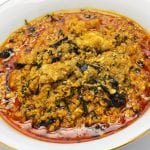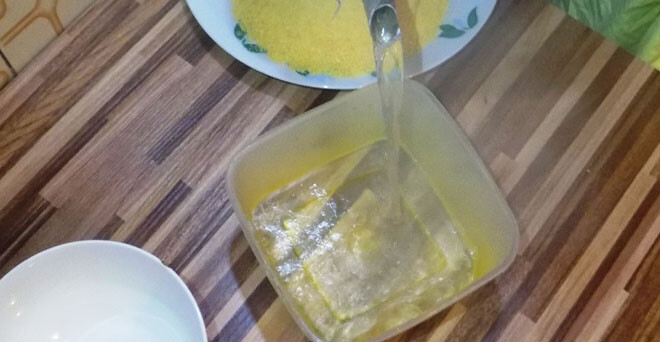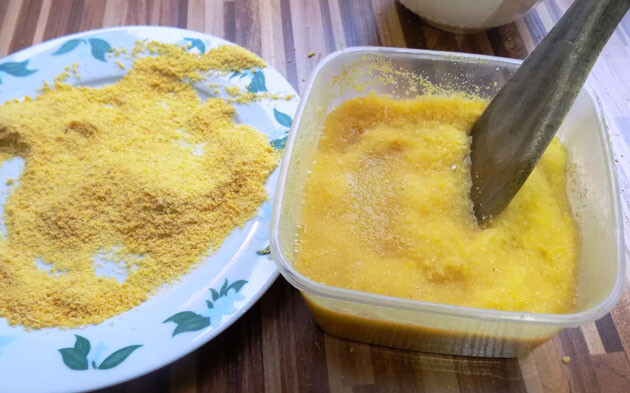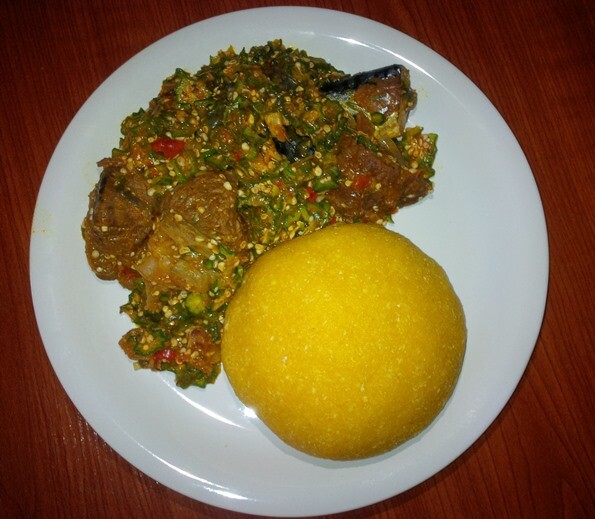WEST AFRICAN RECIPES
Egusi is a West African name for the seeds of plants like squash, melons, and gourds that, when dried and ground become a staple ingredient in many West African dishes. Particularly, in Nigerian culture, egusi is a popular with pounded yam. These seeds are rich in fat and protein, and add these essential nutrients into West African Cuisine.
Nigerian Egusi Soup is a soup thickened with ground melon seeds and contains leafy and other vegetables. It is one of the most popular soups prepared by most tribes in Nigeria with considerable variation and often eaten with dishes like Pounded Yams. Prepare it with goat, beef, fish, or shellfish!
Nigerian Egusi Soup Recipes

This recipe will show you how to make Nigerian Egusi Soup, a popular West African soup made with melon seeds.
- 1 cup blended onions (about 3- 5 and fresh chilies, to taste)
- 4 cups egusi (melon seeds, ground or milled)
- 1⁄2 – 1 cup palm oil
- 2 teaspoons fresh Une (Iru, locust beans)
- Salt (to taste)
- Ground crayfish (to taste)
- 7– 8 cups stock
- Cooked Meat & fish (quantity and variety to personal preference)
- 2 cups cut pumpkin leaves
- 1 cup waterleaf (cut)
- 3 tablespoons bitter leaf (washed)
EGUSI PASTE:
- Prepare the egusi paste:
- Blend egusi seeds and onion mixture. Set aside.
MAKE THE SOUP:
- In a large pot, heat the palm oil on medium for a minute and then add the Une.
- Slowly add the stock and set on low heat to simmer.
- Scoop teaspoon size balls of the egusi paste mixture into the stock. Be sure to keep ball shape.
- Leave to simmer for 20 – 30 minutes so the balls cook through.
- Add the meat and fish and other bits which you’d like to use.
- Add cut-up pumpkin leaves.
- Add the waterleaf.
- Stir and put a lid on the pot and allow cook for 7–10 minutes, till the leaves wilt.
Add the bitter leaf. Leave the lid off while the cooking finishes for another 5-10 minutes.
Stir, check seasoning and adjust accordingly.
Now you can sit back and enjoy your delicious Nigerian Egusi Soup!
2. EBA
What is this eba that everyone is talking about?
Sometimes, the most simple things are the most complex. If you are a Nigerian and someone asks you “what is eba” you would be like; what? are you kidding me?”.

Well, while you know the answer to that question, so many other persons from outside Nigeria are still trying to grasp the nitty-gritty of Nigerian cooking.
I get questions like this every day and it doesn’t surprise me.
What is an eba?
What is it made of?
What is garri made of?
Well, I am going to give you a detailed break down via this article and even show you how to make eba from store-bought garri. If you are new to Nigerian cooking, I can understand exactly where you are now.
I have a cookbook at Amazon, it should be available from January 2017 “Beginner’s Guide to Nigerian Cooking”, it is very cheap and you can get it for a quick start to Nigerian cooking.
Eba is a Nigerian staple food eaten all over the country and beyond. It is made from fried grated cassava (manioc) flour, commonly called as garri.
Garri is a by-product of cassava. It goes through a lot of processes before it finally becomes garri. But you don’t need to bother yourself with all of those. We all buy garri from the grocery stores and make eba out of them in just five minutes.
Most of the Soups you would learn to prepare from this blog are not usually served alone in Nigeria. They are served alongside “swallows” – as we call them in Nigeria. There are just about ten of them and eba is the most popular.
This article shows you how to make garri (eba). It usually takes less than 10 minutes.
What You Need:
4 cups of Garri (white or yellow)
bowls
wooden turner
Hot water.
Serving: 4
This is what store-bought garri looks like. You can buy this from any Nigerian local market or grocery store.
Buy either the white or yellow garri and you are good to go.
How to make Eba
Step 1
Boil water and pour it into a bowl.
Step 2
Sprinkle the garri into the boiled water. continue until the eba thickens. You can add more garri if it is too soft or add water if it is very hard.


Once the eba is well stirred to achieve a fine consistency, you can serve with any soup.
Step 3
You should be able to mold it in small portions, dip into your delicious soup and swallow.
Eba is served with any one of the popular Nigerian soup. I think it is the most popular Nigerian swallow.
That is how I prepare (garri), tell me how you prepare your own using the comment form below. I hear some just pour boiled water over the garri. Is that what you do? Tell me via the comment form below.
You can also learn about pounded yam, they serve the same purpose.
Served with okro soup
Banku and Tilapia with Peppers Stew
Banku and Tilapia with Peppers Stew is as traditional and favorite dish as it gets in Ghana!

(Photo Attributed to Author: Jake Brown)
Banku and Tilapia with Peppers Stew Recipe-
Ingredients:
- one whole tilapia fish (if you can get it, fresh and whole, great. If not, you can use two tilapia filets)
- 1 tomato, rough chopped
- 1 cup of hot peppers, the Ghanaians use Kpakpo Shito (also called scotch bonnets), so use them if you can
- 1 cup of chopped onion
- 4 large cloves fresh garlic, fine chopped
- 1 Maggi cube (special African seasoning cube, and an absolute must-have ingredient, for authentic results)
- salt and pepper to taste
Directions:
- Grille or broil your whole tilapia, or tilapia filets.
- Either use a blender or food processor to mash and blend a cup of chopped onions and a cup of hot peppers. (Note: if you really want the true African cooking experience, you can do this using a mortar and pestle).
- Add and stir in the chopped tomatoes and peppers, and blend some more.
- Pour some cooking oil into a sauce pan and bring the heat up to medium high.
- Pour the blended mixture into the sauce pan.
- Crush the Maggi Cube and put it into the cooking mixture. Reduce heat to just a simmer.
- Add some salt and pepper to taste.
- Stir all ingredients together well, cover the pan, and bring the stew to a vigorous simmer, keep cooking until all the juice from the tomatoes is cooked out, and you are left with a very thick, spicy stew.
- Serve your Banku and Tilapia with Peppers Stew as follows:
Place the fish and peppers on one plate, with a fist-sized ball
of banku on one side of the side dish, and always provide a bowl of
fresh clean water, some hand soap, and a drying linen, because you
eat this delightful meal with your hands. The banku is your “edible
utensil” – you break off small pieces, mold it into a soft little cup shape,
then use that to scoop up the stew or break off a piece of fish, then
pop the whole delightful morsel in your mouth. YUMMY!

